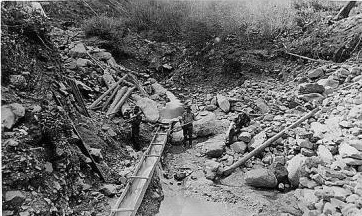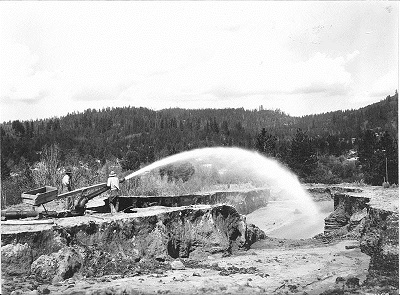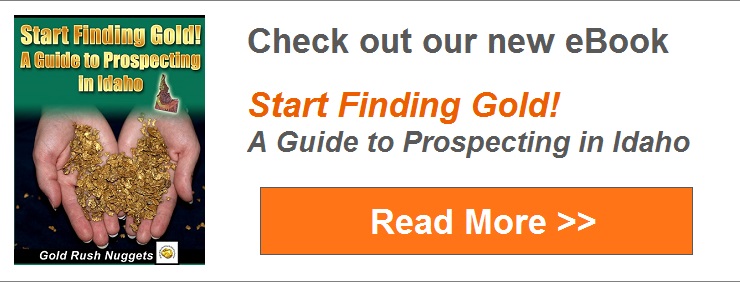
They may not have known it when the first flakes of gold were found, but gold discoveries throughout the Boise Basin would eventually become the largest gold strike in Idaho history.
It all began with the Indians…
In 1862 George Grimes was living a peaceful life in Walla Walla, Washington until he heard a tale told by some Indians. The tale told him about the Boise Basin. Indians boasted that there was so much gold there that it could be picked up from the surface in handfuls. This was a breaking point in George’s fate. He decided to leave his peaceful life in Walla Walla and travel to Idaho (which was not a separate state yet) to look for his fortune.
It turned out that the Indians didn’t lie! That same year, George and some of his partners discovered placer deposits in the Boise River, which the eventually traced upriver to drainages to the creeks that flowed through the Boise Basin. (These creeks would eventually be named Mores Creek and Grimes Creek.)
Grimes would have been rich but for one problem. He was killed just a few days after his discovery. Some speculate that he was murdered by one of his greedy partners but we can never know. Maybe the Indians decided to silence him after all.
An Explosion in Population
So, Gold was discovered in Boise in 1862. By the end of 1863, the area was flooded with people. Towns were constructed one after another everywhere, the biggest of them being Idaho City, Placerville, Centerville and Pioneerville and Quartzburg. Idaho City itself had more than 6,000 citizens and Boise Basin… well, sources state that up to 70,000 people might have moved here in just one year.

This large population was sustained by the fact that the goldfields were extensive and rich. This wasn’t just a small area with a few rich gold mines. Rather, it seemed that every small creek was profitable for a man to work. Gold wasn’t just in the main river bottoms, it was also recovered from small gulches with limited water that would eventually be mined by hydraulic methods.
Mining in the Basin
Prospecting gold in Boise Basin has some interesting aspects. The area has quite a few mountain rivers and so it is ideal for placering. That was the main method of prospecting gold, followed by a more productive use of hydraulic washers which pumped water through sluice boxes in unimaginable quantities. Some river banks were changed forever as a result of that.
Further into the summer many of the creeks dried up, so panning became impractical. That is why people aspired to work as hard as they could from the beginning of spring when snows melted. They only had a few months until early summer. There was even a drought year when people decided to work day and night in order to get enough money for the whole season.

Placer mining on a grand scale continued there for up to 1870s, and while the population diminished year by year, the Boise Basin still sustained a population of miners far longer that most boom-and-bust mining towns.
Hydraulic mining changed the landscape completely, and evidence can still be seen. In towns like Idaho City you can see where the hillsides were scoured out with high pressure water, which was then run through a series of sluices to recover gold.
Also Read: Gold Panning Tips
Bring on the Bucket Dredges
Long after the peak of mining in the Boise Basin, a new technology was discovered that caused a renewed interest in gold mining all throughout the major placer mining districts of the West, including the Boise Basin. This was the invention of the bucket-line dredge, a massive piece of equipment designed to process huge amounts of gravel from river beds. First used in Bannack, Montana at Grasshopper Creek, eventually there were hundreds of dredges being built and operated all around the West.

These dredges were used for miles of river bottoms. The old tailing piles are most evident along Grimes Creek near Centerville. The extend for miles and miles.
The amount of gold that was recovered from these operations was immense, though they were inefficient at times and were known to miss a lot of gold.
Stamp mills sprang up in Boise as hard rock mining got established, but this always was primarily a placer district. Certainly there are many mines extracting lode gold from the mountains north of Boise, but most of the gold recovered was from the placers.
It is said that more than 2 million ounces were produced only in Idaho City during the period of 1863 up to the turn of the century.
When the Rush Ended
Despite the fact that placer mining and dredging was mostly finished by 1950s, people can still get a moderate amount of gold from mines. In fact, the jump in precious metal prices over the past decade has renewed interest in this area.
Of course, small-scale placer mining has always remained popular. A person can still recover some gold from the creeks with relative ease if you know of a good spot to dig and pan.
Next: Staking a Mining Claim

